Transnotating Carlos Gamma

This is a follow-up to “C central note layout”.
After finding a “reasonable” note layout to play Carlos Gamma with my Chameleon the next question has been: how do I notate that?
What follows is my solution to it, for the time being.
I started remapping the notes of the Gamma mode I have used with my Halberstadt keyboard (see the above mentioned article).

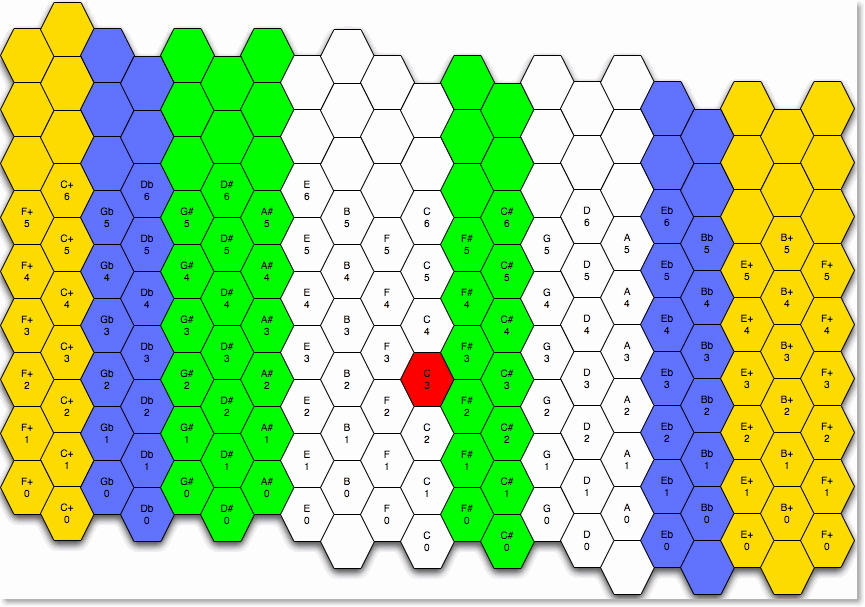
These 77 notes correspond to the Chameleon’s white and green columns of the above picture (notes without labels are outside the MIDI range).
So, for example, this is what happens when I press the C3 button on the Chameleon:

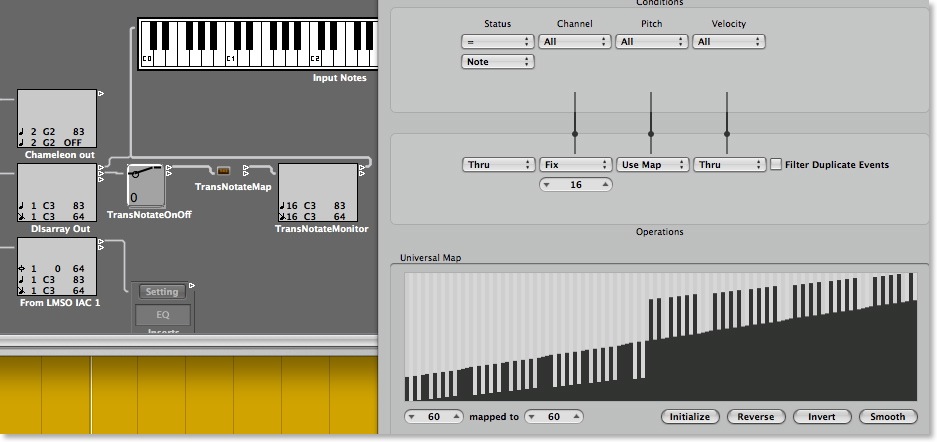
C3 is the anchor key, so it is the only one that does not need any transnotation.
The above picture shows a Logic Pro’s environment layer.
You can see that the MIDI output from the Chameleon would be G2 that is remapped to C3 by Disarray. From there the signal goes to LMSO and then to the sound source.
At the same time the signal (from Disarray) can be sent to a Transformer map I call TransNotateMap that you see opened on the right side of the above picture. C3 (MIDI note 60) is not remapped but its MIDI channel is changed to 16 to distinguish notes going to the sound source from those used only for the transnotated score.
Let’s see another example:

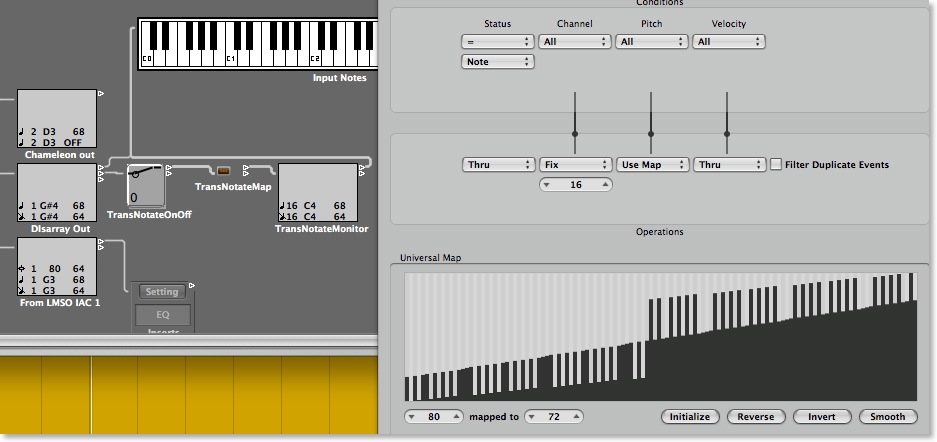
The above picture shows what happens when I press C4 on the Chameleon (compare this picture with the previous one): the Chameleon outputs note D3 because it is using the Melodic Table layout.
Disarray remaps it to G#4 (MIDI note 80), 20 MIDI notes above C3 that in Carlos Gamma equal a 3:2 interval (as before the signal goes to LMSO and then to the sound source). If I turn the TransNotateOnOff switch to 0, as in the above picture, the signal goes also to the above mentioned map that remaps it to MIDI note 72 (C4) on channel 16, 12 notes above note 60, an octave in standard notation but not on my Carlos Gamma one (see the above mentioned article on this matter).
Something similar happens pressing, for example, C5. See the following picture. I let you to figure out what happens!

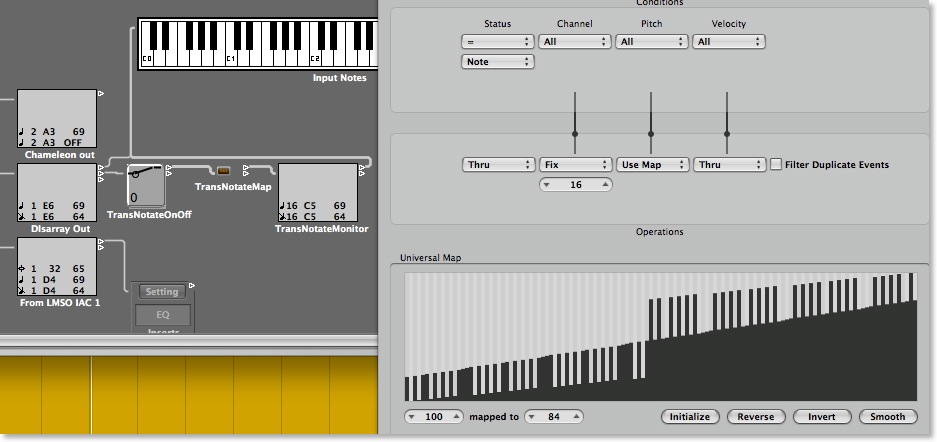
This procedure is the same for the all 77 keys of white and green columns of the Chameleon and it automates the transnotation of all these keys.
These 77 keys are remapped to MIDI notes 24 to 100 (included). This layout leaves MIDI note ranges 0-23 and 101-127 free to accommodate the remaining 51 notes of the blue and yellow columns of the Chameleon (51 + 77 = 128 MIDI notes). Of these 51 notes those below MIDI note 60 are allocated to the lower range and those above 60 to the upper one.
You can download the complete diagram of the above map here. Let’s look at the first 4 lines of it to explain what I did:

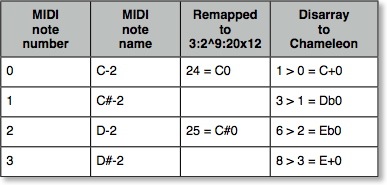
MIDI note 0 is remapped to note 24 so I can remap MIDI note 1 to 0.
I use the symbol “1 > 0 = C+0” to mean: MIDI note 1 remapped to MIDI note 0 equals key C+0 that in my notation is the one immediately above C0 (1 Gamma step = 35.098 cents) .
Now I can remap MIDI note 3 to MIDI note 1 and call it Db0 (I can not remap MIDI note 2 twice!) et cetera.
You can see that this map consists of 2 sub-maps: the one called “Remapped to 3:2^9:20x12” and the other one called “Disarray to Chameleon”.
The second one does not map notes correctly and need to be edited by hand in order to comply to my Carlos Gamma notation.
The question now is: is it worth it?
This system is not perfect because it is only “semi-automated” but it is better than not being able to notate anything at all as it has been sofar.
This system automatically transnotate 12 out of the 20 steps of Carlos Gamma. The priority has been given to the dodecatonic mode of Carlos Gamma called “3:2^9:20x12” that I have been using extensively. My first piece featuring it was Adagio Gamma and it was the first one I ever composed with this tuning system. At that time I was still waiting for my Chameleon to arrive. That mode is perfectly capable of creating beautiful melodies and haunting harmonic textures. The remaining 8 steps of Carlos Gamma need some more work to transnotate.
Let’s look at a couple of short movies to see what is going on.
CLICK HERE TO WATCH “TRANSNOTATION 1”
The one above shows a short phrase that includes notes on white, green and blue columns of the Chameleon.
The first time you see notes sent to LMSO and to the sound source (G-Force impOSCar).
You can see that I have copied the track sent to LMSO to TransNotateMap in order to create the automated score you see the second time. The third time you see the edited (and final) score.
Those 2 high notes you see at the end of bar 2 and 3 (the second time) are those on the blue columns. They are not mapped correctly but, at least, are easily spotted because out of range (to know how to transnotate them I have to look at the above mentioned diagram). You can also see that I have to manually edit the last note of bar 1 from Ab to G# because in my notation there is no enharmonic equivalence between flats and sharps.
So, you can see, the system is not straightforward, it is convoluted but again, it is better than nothing!
It is even more convoluted when I play notes on yellow columns!
CLICK HERE TO WATCH “TRANSNOTATION 2”
On the above movie I repeat the same phrase as before but starting on a different note. Now I use notes on white, green, blue and yellow columns.
The first time you see notes sent to LMSO and to the sound source.
The second time you see the automated score with 3 notes way above all the other ones, the first one is a “blue” one, the other 2 are “yellow” ones (as before I have to manually transnotate them referring to the above mentioned diagram), I have to manually turn Bbs into A#s (“green” notes) and notate the 2 “yellow” ones with different noteheads.
Is that enough?
You have to consider that sofar all I have done with Carlos Gamma has been done by ear that, of course, is a perfectly legitimate way of doing things but now I have an alternative. With some efforts I can notate things, analyze them and so forth.
CLICK HERE TO WATCH “TRANSNOTATION 3”
The above movie is me playing the 2 phrases of the previous video examples so you can see how I play them.
I don’t expect anyone else to use this system but probably it could suggest a way to transnotate other microtonal tuning systems, especially those with macrointervals like Bohlen Pierce. I am not a fan of it so I will not spend any time researching it but someone else could!


